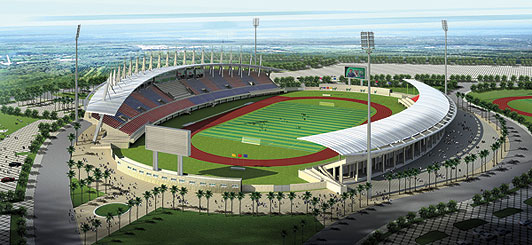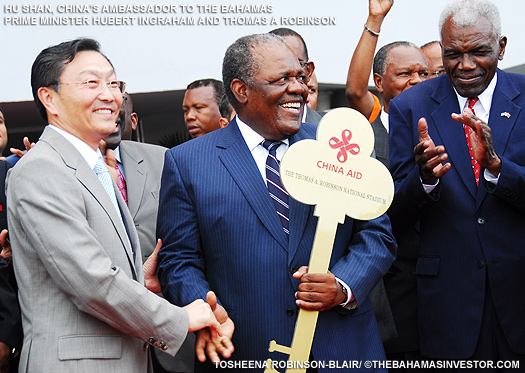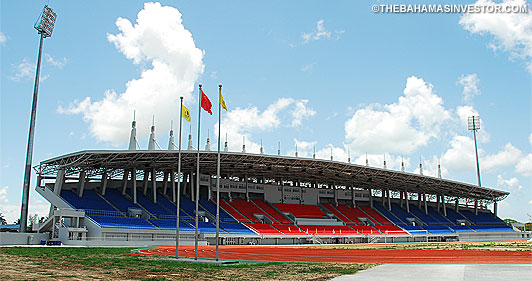| Source: Date: Updated: Author: |
TheBahamasInvestor.com
Thursday, June 23, 2011 Thursday, June 23, 2011 Tosheena Robinson-Blair |
Two years after construction commenced, The People’s Republic of China yesterday officially handed over the new, ultra-modern $30-million Thomas A Robinson National Stadium to the Bahamian people–a gift hailed by Prime Minister Hubert Ingraham as a symbol of good bilateral relations.
“The gift of this stadium by the Chinese government is, I believe, a most generous demonstration of the good relations that have developed between our two governments and peoples since the establishment of diplomatic relations in 1997,” said Ingraham at the handover ceremony.
The stadium is the “jewel in the crown” of what is expected to be a thoroughly modern, world-class sports centre, with facilities extending over some 450 acres.
“This Thomas A Robinson National Stadium is the flagship structure of the Queen Elizabeth Sports Centre redevelopment project which represents the single largest investment in sports development in the history of the Commonwealth of The Bahamas,” said Minister of Youth, Sports and Culture, Charles Maynard.
The stadium comprises just over 190,000 sq ft. It has 15,000 fixed seats, including sky boxes and a number of disable-friendly seats. Other features include a state-of-the-art security surveillance system, audio/visual equipment, meeting rooms, offices and suites.
The running track will be certified by the International Association of Athletics Federation (IAAF) and the infield meets the Federation of International Football Association (FIFA) standards.
The Chinese broke ground for the stadium on July 10, 2006. The following month a construction contract was concluded with Qilu Construction Group Corp. Construction did not proceed, however, as the government sought a number of modifications to the design. The construction documents were finalized in October 2007 and construction commenced on the stadium in July 2009.
The construction project, carried out by Chinese nationals, employed some 326 personnel. Just over 100 Bahamian entities provided goods and services for the stadium’s construction. In all, some $9.5 million–roughly a third of the total cost–was injected into the Bahamian economy over the two-year construction period.
“This project can surely be regarded as a symbol of the development of our two countries friendly relationship,” said Hu Shan, China’s Ambassador to The Bahamas. “It promotes high level contact between our two countries and increases the understanding and relations between our two peoples.”
The ambassador noted that the stadium is “a very important platform” to enhance bilateral exchange in the fields of sports and culture.
“This is why the Chinese government and people present the stadium to the Bahamian government and people,” he said through an interpreter.
Intimately involved with the project from day one was Olympian Thomas A Robinson, after whom the stadium is named.
“Today gives me a great deal of satisfaction,” said Robinson, a legend in Bahamian sports, who was the first Bahamian to compete in track and field in the Olympic Games.
“When the national stadium committee was appointed in 2004, with its mandate for a 10,000-seat stadium, I never really expected to be around to witness this dream,” said Robinson. Hope came alive after the contract signing in April 2005, but shortly afterwards he was diagnosed with stomach cancer.
“This has been a very heartwarming experience for me,” said Robinson, who serves as chairman of the National Stadium Committee. “I shall be ever grateful to all those who contributed to this magnificent facility in any way.”
 The stadium and its ancillary work is part of the government’s overall plan for transforming the landscape of New Providence, providing residents and visitors alike with modern and reliable infrastructure and utility services.
The stadium and its ancillary work is part of the government’s overall plan for transforming the landscape of New Providence, providing residents and visitors alike with modern and reliable infrastructure and utility services.
Two months ago, the government signed off on two of the five phases planned for the overall development of the Queen Elizabeth Sports Centre. The scope of works include new roads, parking, green space and drainage.
“We have every confidence that those works included in the contract and this new stadium meet the standards necessary to host major regional and international sporting events,” said Ingraham. “The completion of both will greatly enhance the potential for growth in sports tourism creating new revenue sources that can increase opportunities for additional sports development in The Bahamas.”
The new national stadium and world-class sports centre are expected to help augment the urban redevelopment of the surrounding areas, in addition to enhancing the facilities available to the College of The Bahamas.
The People’s Republic of China technical team will remain in The Bahamas during the one-year transition period, training Bahamian staff in the use of the equipment and the maintenance of the national stadium.
“It’s a great honour for Shandong Hi Company to build this national stadium,” said Sun Liang, chairman of the Shandong Hi-Speed Group, the project’s contractor. Speaking through an interpreter, Liang noted that builders overcame numerous obstacles and “spared no expense” in constructing the new facility.

tblair@dupuch.com











